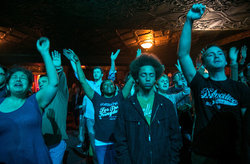
The National Congregations Study, directed by Mark Chaves of Duke Divinity School, has tracked changes in American congregational life since 1998. The most recent findings give an updated look at the modern church.
The new data shows six trends redefining the shape of the church today.
1. Separation between smallest and largest churches widens.
The average church in America is shrinking, but the average churchgoer is attending a larger church. The average congregation has only 70 regular participants, but the average attendee worships in a congregation with about 400 regular participants.
The largest 7 percent of churches contain about half of all churchgoers. The separation between the shrinking small churches and the growing large churches has only widened since the survey began in 1998.
However, those in smaller churches give more per capita than those in larger churches. A congregation of 100 adults receives about 18 percent more per capita than a congregation with 400 adults.
More churches are claiming no denominational affiliation, which is increasingly common among megachurches. From 1998 to 2012, the percentage of congregations operating outside a denomination grew from 18 to 24 percent.
2. Diversity is increasing.
Church staff is getting more diverse. Overall, 13 percent of senior pastors and 15 percent of other staff within historically white religious traditions are African American, Hispanic, or Asian. Catholics are by far the most diverse, with mainline being the least. Among evangelicals, 14 percent of senior pastors and 17 percent of other staff are ethnic minorities.
Churches themselves are also more diverse. The percentage of churches where no ethnic group constitutes at least 80 percent of the congregation grew to 20 percent in 2012. Among predominately white congregations, the majority have at least some black (69 percent) and Hispanic (62 percent) participants and almost half (48 percent) have Asian participants.
3. Worship services are less formal.
Since 1998, choirs, bulletins, and organs have all declined in churches, while testimonies, saying “Amen,” jumping or shouting, raising hands, applause, drums, and projection equipment have all increased.
In 2012, less than half of all churches used choirs (45 percent) or organs (42 percent) for worship. In 1998, both were used in a majority of churches. Only 35 percent of evangelical churches now use a choir. Projection equipment made the steepest climb, up 23 points to 35 percent of all congregations in 2012.
4. Churches are starting more sites, but fewer worship services.
While 62 percent of congregations have more than one worship service in a typical week, that has become less common. The drop came predominately among smaller churches.
By contrast, multisite is on the rise. While only 3.4 percent of all congregations were multisite in 2012, 10 percent of all churchgoers attended a multisite church. Among churches with at least 500 adult participants, more than 16 percent have multiple locations.
5. Mainline Protestantism continues to decline.
What was once the most vibrant strand of American religiosity continues to wane. Since 1998, mainline Protestant congregations have dropped from 26 percent in 1998 to 20 percent in 2012, the latest year of the research. The percentage of attendees among existing churches has also declined from 24 to 17 percent.
Not only are they in decline, mainline Protestant churches are getting older. The typical American congregation was founded 58 years ago. For mainline churches, it’s 122 years. By comparison, the typical evangelical church is 30 years old.
The older mainline churches are full of older individuals as well. More than half (56 percent) of adults in a typical mainline church are over 60. That age group comprises only a third (32 percent) of the typical evangelical church.
6. Church political engagement defies expectations.
Some churches mix political engagement with their worship, but it might not be the ones you expect. Slightly more than one-third (34 percent) of churches participated in at least one of eight political activities asked about in the survey.
Evangelicals are the least politically active tradition with only 23 percent taking part in at least one activity. One-third (33 percent) of mainline churches, fewer than half (45 percent) of Black Protestants, and three-fourths (75 percent) of Catholics participated in at least one political activity.
Despite the media attention on political engagement, churches are much more likely to be involved in social services—87 percent of churches are involved in some kind of social service.
Churches are twice as likely to have a homeless ministry or be involved in an education service than to have a political candidate as a visiting speaker or lobby an elected official.
This post was written by Aaron Earls. You can find his post here: http://factsandtrends.net/2015/12/17/6-trends-redefining-the-american-church/#.Vn1dsdCTkZF
 RSS Feed
RSS Feed